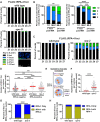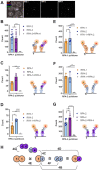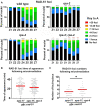RPA complexes in Caenorhabditis elegans meiosis; unique roles in replication, meiotic recombination and apoptosis
- PMID: 33476370
- PMCID: PMC7913698
- DOI: 10.1093/nar/gkaa1293
RPA complexes in Caenorhabditis elegans meiosis; unique roles in replication, meiotic recombination and apoptosis
Erratum in
-
Correction to 'RPA complexes in Caenorhabditis elegans meiosis; unique roles in replication, meiotic recombination and apoptosis'.Nucleic Acids Res. 2021 Sep 7;49(15):9003. doi: 10.1093/nar/gkab631. Nucleic Acids Res. 2021. PMID: 34370030 Free PMC article. No abstract available.
Abstract
Replication Protein A (RPA) is a critical complex that acts in replication and promotes homologous recombination by allowing recombinase recruitment to processed DSB ends. Most organisms possess three RPA subunits (RPA1, RPA2, RPA3) that form a trimeric complex critical for viability. The Caenorhabditis elegans genome encodes RPA-1, RPA-2 and an RPA-2 paralog RPA-4. In our analysis, we determined that RPA-2 is critical for germline replication and normal repair of meiotic DSBs. Interestingly, RPA-1 but not RPA-2 is essential for somatic replication, in contrast to other organisms that require both subunits. Six different hetero- and homodimeric complexes containing permutations of RPA-1, RPA-2 and RPA-4 can be detected in whole animal extracts. Our in vivo studies indicate that RPA-1/4 dimer is less abundant in the nucleus and its formation is inhibited by RPA-2. While RPA-4 does not participate in replication or recombination, we find that RPA-4 inhibits RAD-51 filament formation and promotes apoptosis of a subset of damaged nuclei. Altogether these findings point to sub-functionalization and antagonistic roles of RPA complexes in C. elegans.
© The Author(s) 2021. Published by Oxford University Press on behalf of Nucleic Acids Research.
Figures








Similar articles
-
Dual functions for the ssDNA-binding protein RPA in meiotic recombination.PLoS Genet. 2019 Feb 4;15(2):e1007952. doi: 10.1371/journal.pgen.1007952. eCollection 2019 Feb. PLoS Genet. 2019. PMID: 30716097 Free PMC article.
-
Interdependent and separable functions of Caenorhabditis elegans MRN-C complex members couple formation and repair of meiotic DSBs.Proc Natl Acad Sci U S A. 2018 May 8;115(19):E4443-E4452. doi: 10.1073/pnas.1719029115. Epub 2018 Apr 23. Proc Natl Acad Sci U S A. 2018. PMID: 29686104 Free PMC article.
-
Dynamic Architecture of DNA Repair Complexes and the Synaptonemal Complex at Sites of Meiotic Recombination.Cell. 2018 Jun 14;173(7):1678-1691.e16. doi: 10.1016/j.cell.2018.03.066. Epub 2018 May 10. Cell. 2018. PMID: 29754818 Free PMC article.
-
RPA homologs and ssDNA processing during meiotic recombination.Chromosoma. 2016 Jun;125(2):265-76. doi: 10.1007/s00412-015-0552-7. Epub 2015 Oct 31. Chromosoma. 2016. PMID: 26520106 Free PMC article. Review.
-
Meiotic recombination in Caenorhabditis elegans.Chromosome Res. 2007;15(5):607-21. doi: 10.1007/s10577-007-1146-x. Chromosome Res. 2007. PMID: 17674149 Review.
Cited by
-
The chromatin-associated 53BP1 ortholog, HSR-9, regulates recombinational repair and X chromosome segregation in the Caenorhabditis elegans germ line.Genetics. 2024 Aug 7;227(4):iyae102. doi: 10.1093/genetics/iyae102. Genetics. 2024. PMID: 38884610 Free PMC article.
-
Recruitment of MRE-11 to complex DNA damage is modulated by meiosis-specific chromosome organization.Mutat Res. 2021 Jan-Jun;822:111743. doi: 10.1016/j.mrfmmm.2021.111743. Epub 2021 Apr 20. Mutat Res. 2021. PMID: 33975127 Free PMC article.
-
Upregulated RPA2 in endometrial tissues of repeated implantation failure patients impairs the endometrial decidualization.J Assist Reprod Genet. 2023 Nov;40(11):2739-2750. doi: 10.1007/s10815-023-02946-1. Epub 2023 Oct 13. J Assist Reprod Genet. 2023. PMID: 37831348 Free PMC article.
-
R-loop-induced irreparable DNA damage evades checkpoint detection in the C. elegans germline.Nucleic Acids Res. 2022 Aug 12;50(14):8041-8059. doi: 10.1093/nar/gkac621. Nucleic Acids Res. 2022. PMID: 35871299 Free PMC article.
-
A bacterial expression cloning screen reveals single-stranded DNA-binding proteins as potent desicco-protectants.Cell Rep. 2024 Nov 26;43(11):114956. doi: 10.1016/j.celrep.2024.114956. Epub 2024 Nov 11. Cell Rep. 2024. PMID: 39531375 Free PMC article.
References
-
- Treuner K., Ramsperger U., Knippers R.. Replication protein A induces the unwinding of long double-stranded DNA regions. J. Mol. Biol. 1996; 259:104–112. - PubMed
Publication types
MeSH terms
Substances
Grants and funding
LinkOut - more resources
Full Text Sources
Other Literature Sources
Research Materials

